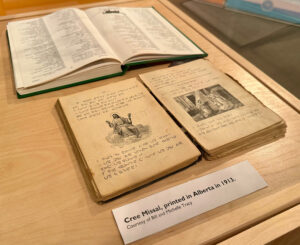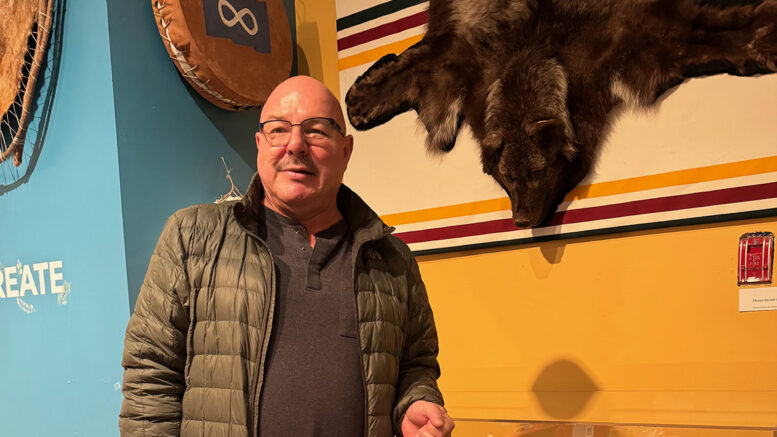by Kinnukana, Local Journalism Initiative Reporter
The Musée Héritage Museum in St. Albert, Alberta is hosting an exhibition called First Languages until Saturday, February 24th, 2024. It is a new exhibition that showcases the original oral nature of Indigenous languages and the challenges of transitioning them to written form.
Throughout the exhibition, there are a series of stations with opportunities to listen and to try to translate Indigenous languages and identify and learn the meaning of the Indigenous names of places, plants and animals in Alberta. Also included in the exhibition are two travelling presentations from the Canadian Language Museum in Toronto.
“The Cree language is the essence of our culture. Our language is a beautiful language. It is a spiritual language.” – Cree teacher Dan Cardinal
One of the displays is called Beyond Words: Dictionaries and Indigenous Languages and it shows the complex relationship between Indigenous languages and dictionaries over several centuries. Martin Bierens, Curator for the Museum said that “Beyond Words talks about the development of Indigenous dictionaries and it tells the history of Indigenous dictionaries. Originally, they were really for trading purposes, involved in the fur trade, then it went into conversion purposes, and now the dictionaries are really focused on revitalizing the languages.”

Cree books on display at the Musée Héritage Museum in St. Albert, until Feb. 24.
Another display called Cree: The People’s Language, shares maps and images which explore the syllabic writing system, word formation, animacy and the future of the Cree language. Martin shared that this display really takes a look at the inner workings of Cree.
One of the pieces of the exhibit is a Syllabics Typewriter on loan from the Provincial Archives of Alberta. Martin stated that “the typewriter is one really special piece of the exhibit. It’s really interesting to look at, as it has standard Roman Orthography on the keys, but the hammer is in Cree Syllabics.” The typewriter holds a lot of history as it was once used to type documents in Cree.
Visitors to the Museum can also see dictionaries and books related to Cree and two well-known local Métis women are also showcased. Victoria Callihoo and Dr. Anne Anderson, a dedicated author and teacher, were instrumental in preserving the Cree language and promoting the Métis heritage.
Dan Cardinal, a dedicated Cree teacher and advocate of the Cree language, and a former Vice-President of the Métis Nation of Alberta, shared his knowledge at the Museum on February 17, 2024. Dan is a fluent Cree and Michif speaker. He spoke about the importance of the Cree language’s past, present and future. Dan said, “The Cree language is the essence of our culture. Our language is a beautiful language. It is a spiritual language because we do everything in fours. There are four directions, four seasons, four cycles in your life. Everything for us pertains to mother earth and father sky because we are all connected. We as human beings are connected to the earth, land, animals and everyone has a purpose in this world. That’s the essence to our language.”
Dan shared that there is a growing demand now for the Cree language, the culture, the history and the traditions. Dan stated:
“We all know that Indigenous people were not allowed to speak their language in residential schools. This created a group of Indigenous people who lost their identity and culture. We all know about Truth and Reconciliation. I believe it is up to us to revitalize it. It is our responsibility as Indigenous people to do that.”
Dan taught everyone some key tips about the Cree language. In the language, Cree only uses fifteen letters of the twenty-six letters in the English alphabet. He shared that when the ‘K’ is caught between two vowels of the alphabet it makes a ‘G’ sound. There is also no stress on the ‘T’ when pronouncing Cree words. Cree words cannot be translated word for word from English to Cree. One must think about the context that they are speaking in first before translating. In Cree, the nouns and verbs are different for the living and the non-living. Unless an individual knows these tips, they will not know how to say certain Cree words properly.
As with Cree, all Indigenous languages are beautiful but can be seen as complex to learn. This exhibition inspires others to begin learning more about the history and evolution of Indigenous languages and will hopefully motivate visitors to pursue more advanced Indigenous language teachings. As Dan stated, “We never say goodbye, we say ‘ekosi maka’ in Cree. We say that’s it for now because we want to see you again!”
You can visit the First Languages exhibit at the Musée Héritage Museum in St Albert until February 24th at the following address: 5 St Anne Street, St Albert, Alberta T8N 3Z9. It is open from 10:00 am – 5:00 pm each day
For more information, go to First Languages – Arts and Heritage Foundation St. Albert



Be the first to comment on "Musée Héritage Museum exhibition explores the history and evolution of Indigenous Languages"